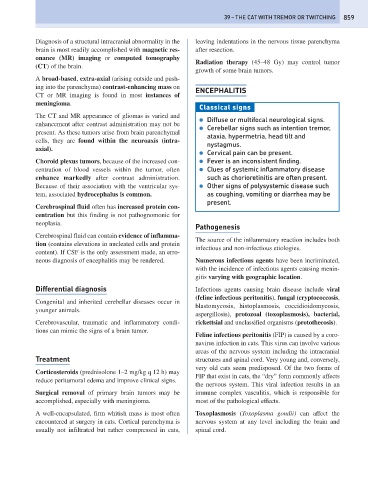Page 867 - Problem-Based Feline Medicine
P. 867
39 – THE CAT WITH TREMOR OR TWITCHING 859
Diagnosis of a structural intracranial abnormality in the leaving indentations in the nervous tissue parenchyma
brain is most readily accomplished with magnetic res- after resection.
onance (MR) imaging or computed tomography
Radiation therapy (45–48 Gy) may control tumor
(CT) of the brain.
growth of some brain tumors.
A broad-based, extra-axial (arising outside and push-
ing into the parenchyma) contrast-enhancing mass on
ENCEPHALITIS
CT or MR imaging is found in most instances of
meningioma.
Classical signs
The CT and MR appearance of gliomas is varied and
● Diffuse or multifocal neurological signs.
enhancement after contrast administration may not be
● Cerebellar signs such as intention tremor,
present. As these tumors arise from brain parenchymal
ataxia, hypermetria, head tilt and
cells, they are found within the neuroaxis (intra-
nystagmus.
axial).
● Cervical pain can be present.
Choroid plexus tumors, because of the increased con- ● Fever is an inconsistent finding.
centration of blood vessels within the tumor, often ● Clues of systemic inflammatory disease
enhance markedly after contrast administration. such as chorioretinitis are often present.
Because of their association with the ventricular sys- ● Other signs of polysystemic disease such
tem, associated hydrocephalus is common. as coughing, vomiting or diarrhea may be
present.
Cerebrospinal fluid often has increased protein con-
centration but this finding is not pathognomonic for
neoplasia.
Pathogenesis
Cerebrospinal fluid can contain evidence of inflamma-
The source of the inflammatory reaction includes both
tion (contains elevations in nucleated cells and protein
infectious and non-infectious etiologies.
content). If CSF is the only assessment made, an erro-
neous diagnosis of encephalitis may be rendered. Numerous infectious agents have been incriminated,
with the incidence of infectious agents causing menin-
gitis varying with geographic location.
Differential diagnosis Infectious agents causing brain disease include viral
(feline infectious peritonitis), fungal (cryptococcosis,
Congenital and inherited cerebellar diseases occur in
blastomycosis, histoplasmosis, coccidioidomycosis,
younger animals.
aspergillosis), protozoal (toxoplasmosis), bacterial,
Cerebrovascular, traumatic and inflammatory condi- rickettsial and unclassified organisms (protothecosis).
tions can mimic the signs of a brain tumor.
Feline infectious peritonitis (FIP) is caused by a coro-
navirus infection in cats. This virus can involve various
areas of the nervous system including the intracranial
Treatment structures and spinal cord. Very young and, conversely,
very old cats seem predisposed. Of the two forms of
Corticosteroids (prednisolone 1–2 mg/kg q 12 h) may
FIP that exist in cats, the “dry” form commonly affects
reduce peritumoral edema and improve clinical signs.
the nervous system. This viral infection results in an
Surgical removal of primary brain tumors may be immune complex vasculitis, which is responsible for
accomplished, especially with meningioma. most of the pathological effects.
A well-encapsulated, firm whitish mass is most often Toxoplasmosis (Toxoplasma gondii) can affect the
encountered at surgery in cats. Cortical parenchyma is nervous system at any level including the brain and
usually not infiltrated but rather compressed in cats, spinal cord.

